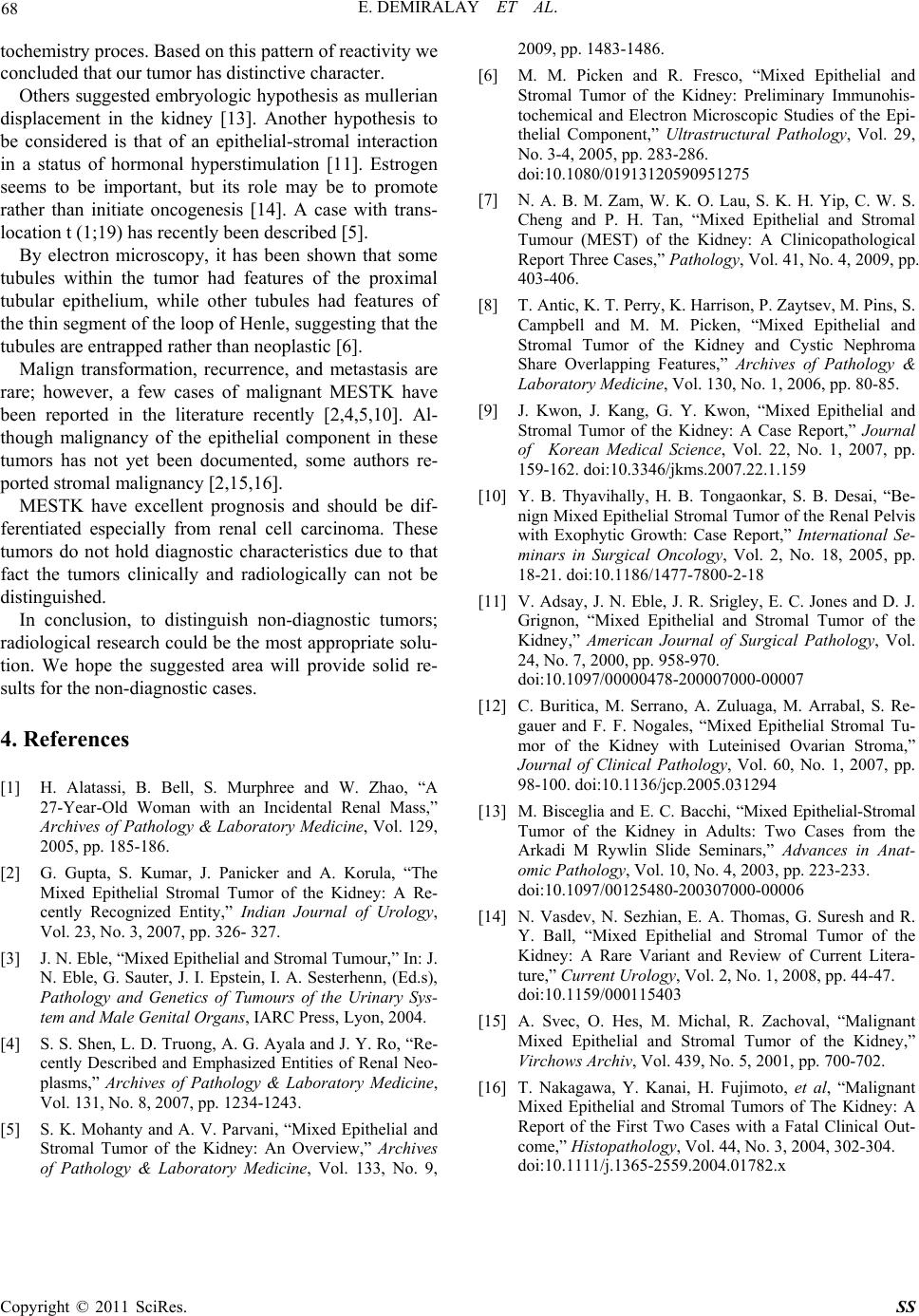
E. DEMIRALAY ET AL.
Copyright © 2011 SciRes. SS
68
tochemistry proces. Based on this pattern of reactivity we
concluded that our tumor has distinctive character.
Others suggested embryologic hypothesis as mullerian
displacement in the kidney [13]. Another hypothesis to
be considered is that of an epithelial-stromal interaction
in a status of hormonal hyperstimulation [11]. Estrogen
seems to be important, but its role may be to promote
rather than initiate oncogenesis [14]. A case with trans-
location t (1;19) has recently been described [5].
By electron microscopy, it has been shown that some
tubules within the tumor had features of the proximal
tubular epithelium, while other tubules had features of
the thin segment of the loop of Henle, suggesting that the
tubules are entrapped rather than neoplastic [6].
Malign transformation, recurrence, and metastasis are
rare; however, a few cases of malignant MESTK have
been reported in the literature recently [2,4,5,10]. Al-
though malignancy of the epithelial component in these
tumors has not yet been documented, some authors re-
ported stromal malignancy [2,15,16].
MESTK have excellent prognosis and should be dif-
ferentiated especially from renal cell carcinoma. These
tumors do not hold diagnostic characteristics due to that
fact the tumors clinically and radiologically can not be
distinguished.
In conclusion, to distinguish non-diagnostic tumors;
radiological research could be the most appropriate solu-
tion. We hope the suggested area will provide solid re-
sults for the non-diagnostic cases.
4. References
[1] H. Alatassi, B. Bell, S. Murphree and W. Zhao, “A
27-Year-Old Woman with an Incidental Renal Mass,”
Archives of Pathology & Laboratory Medicine, Vol. 129,
2005, pp. 185-186.
[2] G. Gupta, S. Kumar, J. Panicker and A. Korula, “The
Mixed Epithelial Stromal Tumor of the Kidney: A Re-
cently Recognized Entity,” Indian Journal of Urology,
Vol. 23, No. 3, 2007, pp. 326- 327.
[3] J. N. Eble, “Mixed Epithel ial and St romal Tu mour,” In: J.
N. Eble, G. Sauter, J. I. Epstein, I. A. Sesterhenn, (Ed.s),
Pathology and Genetics of Tumours of the Urinary Sys-
tem and Male Genital Organs, IARC Press, Lyon, 2004.
[4] S. S. Shen, L. D. Truong, A. G. Ayala and J. Y. Ro, “Re-
cently Described and Emphasized Entities of Renal Neo-
plasms,” Archives of Pathology & Laboratory Medicine,
Vol. 131, No. 8, 2007, pp. 1234-1243.
[5] S. K. Mohanty and A. V. Parvani, “Mixed Epithelial and
Stromal Tumor of the Kidney: An Overview,” Archives
of Pathology & Laboratory Medicine, Vol. 133, No. 9,
2009, pp. 1483-1486.
[6] M. M. Picken and R. Fresco, “Mixed Epithelial and
Stromal Tumor of the Kidney: Preliminary Immunohis-
tochemical and Electron Microscopic Studies of the Epi-
thelial Component,” Ultrastructural Pathology, Vol. 29,
No. 3-4, 2005, pp. 283-286.
doi:10.1080/01913120590951275
[7] N. A. B. M. Zam, W. K. O. Lau, S. K. H. Yip, C. W. S.
Cheng and P. H. Tan, “Mixed Epithelial and Stromal
Tumour (MEST) of the Kidney: A Clinicopathological
Report Three Cases,” Pathology, Vol. 41, No. 4, 2009, pp.
403-406.
[8] T. Antic, K. T. Perry, K. Harrison, P. Zaytsev, M. Pins, S.
Campbell and M. M. Picken, “Mixed Epithelial and
Stromal Tumor of the Kidney and Cystic Nephroma
Share Overlapping Features,” Archives of Pathology &
Laboratory Medicine, Vol. 130, No. 1, 2006, pp. 80-85.
[9] J. Kwon, J. Kang, G. Y. Kwon, “Mixed Epithelial and
Stromal Tumor of the Kidney: A Case Report,” Journal
of Korean Medical Science, Vol. 22, No. 1, 2007, pp.
159-162. doi:10.3346/jkms.2007.22.1.159
[10] Y. B. Thyavihally, H. B. Tongaonkar, S. B. Desai, “Be-
nign Mixed Epithelial Stromal Tumor of the Renal Pelvis
with Exophytic Growth: Case Report,” International Se-
minars in Surgical Oncology, Vol. 2, No. 18, 2005, pp.
18-21. doi:10.1186/1477-7800-2-18
[11] V. Adsay, J. N. Eble, J. R. Srigley, E. C. Jones and D. J.
Grignon, “Mixed Epithelial and Stromal Tumor of the
Kidney,” American Journal of Surgical Pathology, Vol.
24, No. 7, 2000, pp. 958-970.
doi:10.1097/00000478-200007000-00007
[12] C. Buritica, M. Serrano, A. Zuluaga, M. Arrabal, S. Re-
gauer and F. F. Nogales, “Mixed Epithelial Stromal Tu-
mor of the Kidney with Luteinised Ovarian Stroma,”
Journal of Clinical Pathology, Vol. 60, No. 1, 2007, pp.
98-100. doi:10.1136/jcp.2005.031294
[13] M. Bisceglia and E. C. Bacchi, “Mixed Epithelial-Stromal
Tumor of the Kidney in Adults: Two Cases from the
Arkadi M Rywlin Slide Seminars,” Advances in Anat-
omic Pathology, Vol. 10, No. 4, 2003, pp. 223-233.
doi:10.1097/00125480-200307000-00006
[14] N. Vasdev, N. Sezhian, E. A. Thomas, G. Suresh and R.
Y. Ball, “Mixed Epithelial and Stromal Tumor of the
Kidney: A Rare Variant and Review of Current Litera-
ture,” Current Urology, Vol. 2, No. 1, 2008, pp. 44-47.
doi:10.1159/000115403
[15] A. Svec, O. Hes, M. Michal, R. Zachoval, “Malignant
Mixed Epithelial and Stromal Tumor of the Kidney,”
Virchows Archiv, Vol. 439, No. 5, 2001, pp. 700-702.
[16] T. Nakagawa, Y. Kanai, H. Fujimoto, et al, “Malignant
Mixed Epithelial and Stromal Tumors of The Kidney: A
Report of the First Two Cases with a Fatal Clinical Out-
come,” Histopathology, Vol. 44, No. 3, 2004, 302-304.
doi:10.1111/j.1365-2559.2004.01782.x